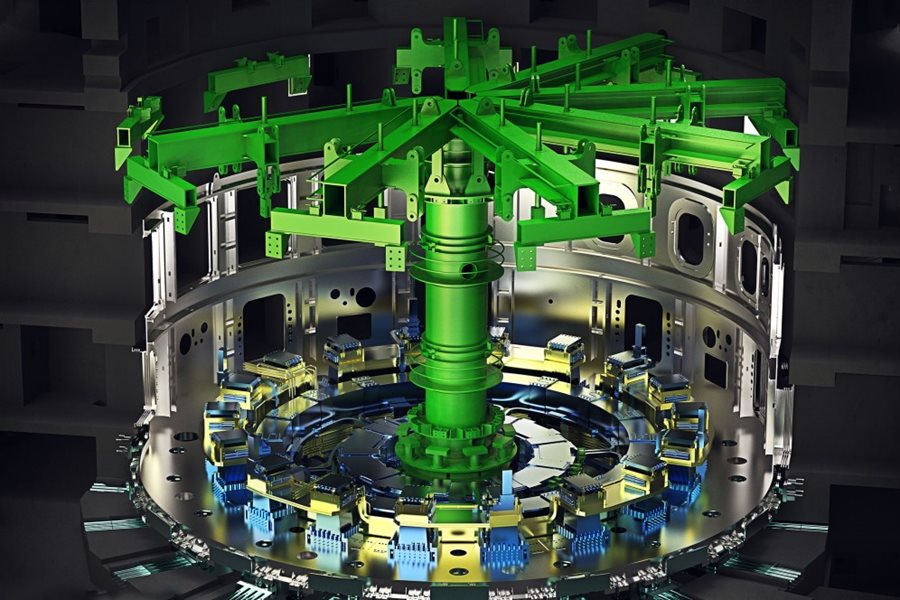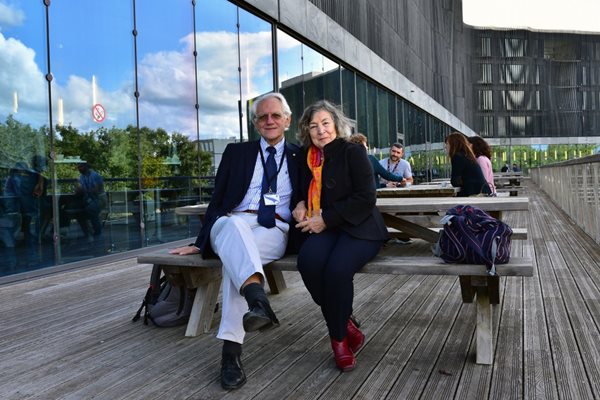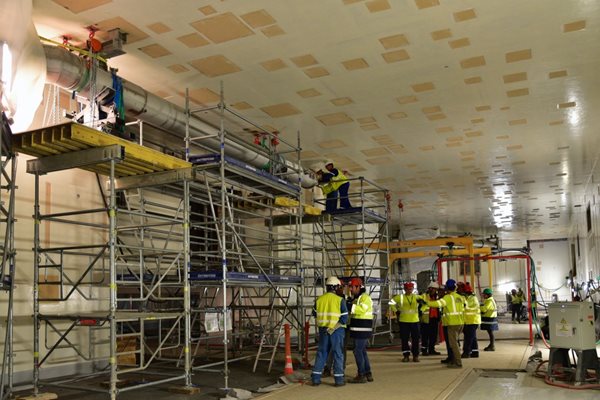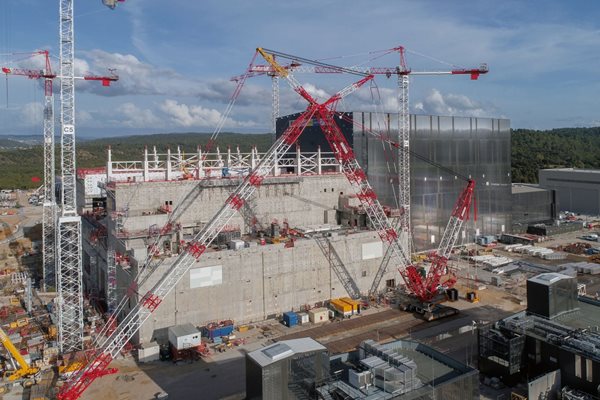
you're currently reading the news digest published from 21 Oct 2019 to 28 Oct 2019
featured4
press5
featured
Tooling | A colossus at the centre of the Tokamak pit
An imposing tool will rise next year in the centre of the Tokamak pit, formed from a trunk-like central column and nine radial beams. During in-pit assembly operations, it will support, align, and stabilize the vacuum vessel sub-assemblies as they are joined and welded. Together with the giant sector sub-assembly tools (SSATs) and the upending tool, the in-pit assembly tool is the third major purpose-built tool supplied by ITER Korea for activities related to the assembly, including in-field joints, of the vacuum vessel sectors. The three tools are closely associated: The upending tool is used to raise vacuum vessel sectors from their horizontal delivery configuration to vertical. After each 'upending' operation, a radial beam is removed from the in-pit column tool and transported by overhead crane to connect to the sector in its vertical orientation. The radial beam, suspending its load, is transported to one of the SSAT tools, where it continues to support the weight of the sector as a pair of toroidal field coils and thermal shield panels are rotated inward and attached. The completed sector sub-assembly—composed of the vacuum vessel sector (still suspended from its radial beam), two toroidal field coils and thermal shielding—is transported by overhead crane through a purpose-built 'sector lifting tool' to the Tokamak Pit. During alignment and welding activities, the weight of the sector continues to be supported by the radial beam while the coils and thermal shield are braced from below by gravity supports installed on the cryostat base. The same procedure is repeated nine times, for nine vacuum vessel sectors. Virtual axis and vertical access The central column—25 metres tall, 5 metres in diameter—is anchored directly to the Tokamak Complex basemat through an opening in the cryostat base, while the radial beams are supported by the central column on one side and the concrete bioshield on the other through brackets embedded in the L2 level of the bioshield wall. The tool is designed to support a total nominal weight of 5,400 tonnes. In addition to its weight-bearing role, the central column of the tool will also provide a physical reference of the machine axis, by which all toroidal field coils can be adjusted precisely. 'In the Tokamak pit, there will be pre-established datum for sector assembly and corresponding virtual axis to which the central column will be aligned,' explains Hyung Yeol Yung, who leads the Assembly Support Section. 'The central column then becomes a good reference to provide the virtual axis for the alignment of the toroidal field coils, through a number of 'fiducial points' mounted on the central column. When toroidal field coil assembly has been achieved, a new datum and virtual axis will be re-defined for the other superconducting coils, which will be mounted on toroidal field coil structure.' Vacuum vessel adjustment and alignment units—located on the radial beams—will allow operators to align the position of each sector for in-pit welding, and align the sectors against the toroidal field coils. Finally, the central column will provide contractor access to assembly activities in an extremely crowded in-pit environment. Although strengthened by interior ribs at regular intervals, the interior of the column is essentially hollow, and will be equipped with interior ladders, traps and staging at four levels. Manufacturing on the in-pit assembly tool is progressing now in Korea at Yujin Machinery in Changwon and factory acceptance tests are scheduled for November. If all goes as planned, the tool will reach ITER before the end of the year. Tool assembly will begin after the installation of the cryostat base in the Tokamak pit next spring. Following the assembly of the central column, a comprehensive metrological survey will be performed to measure the as-built position before reception of the first vacuum vessel sub-assembly.
Visit | Our neighbour the Nobel
In 2018, the Nobel Prize in Physics was awarded to Gérard Mourou for his work on ultra-short, extremely high-intensity laser pulses—the so-called 'chirped pulse amplification' (CPA). Last week, the French physicist and his wife came to ITER as neighbours. Throughout his childhood, Mourou spent the long French summer vacations with his grandparents in a nearby village. The Nobel Prize was responding to an invitation from Greg de Temmerman, a plasma physicist at ITER, following a recent conference in Marseille where both Mourou and ITER Director-General Bernard Bigot were plenary speakers. Although he had never come to ITER before, Mourou has followed the project from afar, catching an occasional glimpse of the worksite when he would return to his grandparents' village. 'What I knew is that there is a very capable team managing this immensely ambitious project and that success can now be contemplated.' Whether a Nobel Prize or not, a visitor to ITER experiences something of a shock—the sheer size of the buildings and assembly tools, the volumes, the maze-like galleries... 'Very, very impressive,' he commented after his tour. 'I have seen many large scientific installations—CERN, the Laser Mégajoule, NIF—but this is quite unique. And one really feels that things are progressing.'
Cryoline installation | Some like it cold
In the ITER Tokamak, several components need to be cooled to extremely low temperatures. Cold, sometimes as intense as in the most frigid places in the Universe, is essential to the superconducting magnets and the thermal shield, as well as to the cryopumps that achieve the high vacuum inside the machine. The massive quantity of cooling fluids that ITER operation requires is produced in the cryoplant, an industrial installation as high as a seven-storey building and with a footprint the size of two soccer fields. This 'cold factory' ranks today as the most powerful single-platform cryoplant in the world. Inside the cryoplant, 5,000 tonnes of equipment and machines (cold boxes, compressors, phase separators, dryers, pumps, etc.) will process helium and nitrogen in different 'phases'— liquid nitrogen at 80 K (minus 193 °C) to be used as a pre-cooler in the helium liquefaction process; liquid helium at 4 K (minus 269 °C) to cool the magnets and cryopumps; and gaseous helium at 80 K for the thermal shield. The cooling fluids produced by the cryoplant will be delivered to an array of some thirty feeders connected to the Tokamak. Before reaching the feeders however, the fluids will need to travel the distance between the cryplant and the Tokamak Building—a 300-metre journey through the insulated piping of the cryolines. In September, the installation of the first sections of cryoline began at the lowermost level of the Tokamak Building. From the outside, a 10-metre-long cryoline section looks like an ordinary steel pipe. It is in fact a high-technology component, ranging from 25 to 1000 millimetres in diameter and hosting up to seven inner pipes, each dedicated to carrying a different fluid.The cryoline network is a vacuum vessel in its own right, with every inner pipe carefully and individually insulated to prevent thermal losses through convection, radiation or conduction. Manufactured under Indian Domestic Agency contract partly in India and partly in France, the cryolines form a 2.7-kilometre network that circles the bioshield and connects to the feeders at the lower and upper levels of the machine. In the lowest basement level of the Tokamak Building, the first cryoline sections, weighing 1 to 3 tonnes in average, are now in place. 'We have to be very careful in positioning the sections, with tolerances that do not exceed few millimetres,' says David Grillot, the head of ITER Cryogenic System Section. Once a section is positioned, each individual pipe inside must be welded, as must the external jacket and its corresponding inner thermal shield. Welded to the embedded plates in the gallery's ceiling, the supports holding the cryolines sections need to be particularly robust. Not only do they have to carry the full weight of the cryolines, but they must also withstand the forces that will be generated when the cryolines contract under the effect of intense cold—when liquid helium at minus 269° begins to flow inside the cryolines, a 10-metre pipe will shrink in length by 3 centimetres. Although flexible bellows will absorb part of the shrinking, the effort exerted on the supports will be in the range of a dozen tonnes. There are some 50 cryoline sections to position and weld in the gallery at the basement level of the Tokamak Building. Once they reach 'cruising speed,' the teams expect to be able install three sections per week. There are approximately 500 sections to install throughout the entire building ...
Video | Preparing for the assembly phase
In the spring of 2020, as the first machine components are lowered by overhead crane into the assembly pit, a new chapter will open in the history of ITER construction. The aligned pillars on top of the Tokamak Building are the most visible elements of the works underway to prepare for that phase. The 28-tonne pillars are part of a massive steel structure that will create a crane hall above the assembly pit and permit the extension of the rails that support the heavy lift bridge cranes. A monster crawler crane, with a boom reaching more than a hundred metres in height, was brought in to perform the lifting and installation of the steel elements; a second will soon join it for the installation of the roof segments beginning in December. Click here for a recent video of the pillars, crawler crane and ongoing works in and around the Tokamak Complex (Courtesy of Manitowoc cranes).



